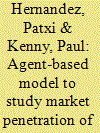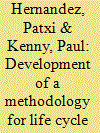|
|
|
Sort Order |
|
|
|
Items / Page
|
|
|
|
|
|
|
| Srl | Item |
| 1 |
ID:
105798


|
|
|
|
|
| Publication |
2011.
|
| Summary/Abstract |
A spatially explicit agent-based vehicle consumer choice model is developed to explore sensitivities and nonlinear interactions between various potential influences on plug-in hybrid vehicle (PHEV) market penetration. The model accounts for spatial and social effects (including threshold effects, homophily, and conformity) and media influences. Preliminary simulations demonstrate how such a model could be used to identify nonlinear interactions among potential leverage points, inform policies affecting PHEV market penetration, and help identify future data collection necessary to more accurately model the system. We examine sensitivity of the model to gasoline prices, to accuracy in estimation of fuel costs, to agent willingness to adopt the PHEV technology, to PHEV purchase price and rebates, to PHEV battery range, and to heuristic values related to gasoline usage. Our simulations indicate that PHEV market penetration could be enhanced significantly by providing consumers with ready estimates of expected lifetime fuel costs associated with different vehicles (e.g., on vehicle stickers), and that increases in gasoline prices could nonlinearly magnify the impact on fleet efficiency. We also infer that a potential synergy from a gasoline tax with proceeds is used to fund research into longer-range lower-cost PHEV batteries.
|
|
|
|
|
|
|
|
|
|
|
|
|
|
|
|
| 2 |
ID:
105797


|
|
|
|
|
| Publication |
2011.
|
| Summary/Abstract |
Traditionally the majority of building energy use has been linked to its operation (heating, cooling, lighting, etc.), and much attention has been directed to reduce this energy use through technical innovation, regulatory control and assessed through a wide range of rating methods. However buildings generally employ an increasing amount of materials and systems to reduce the energy use in operation, and energy embodied in these can constitute an important part of the building's life cycle energy use. For buildings with 'zero-energy' use in operation the embodied energy is indeed the only life cycle energy use. This is not addressed by current building energy assessment and rating methods.
This paper proposes a methodology to extend building energy assessment and rating methods accounting for embodied energy of building components and systems. The methodology is applied to the EU Building Energy Rating method and, as an illustration, as implemented in Irish domestic buildings. A case study dwelling is used to illustrate the importance of embodied energy on life cycle energy performance, particularly relevant when energy use in operation tends to zero. The use of the Net Energy Ratio as an indicator to select appropriate building improvement measures is also presented and discussed.
|
|
|
|
|
|
|
|
|
|
|
|
|
|
|
|
|
|
|
|
|